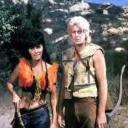Yahoo Answers is shutting down on May 4th, 2021 (Eastern Time) and beginning April 20th, 2021 (Eastern Time) the Yahoo Answers website will be in read-only mode. There will be no changes to other Yahoo properties or services, or your Yahoo account. You can find more information about the Yahoo Answers shutdown and how to download your data on this help page.
Trending News
What if the sun were a red dwarf?
Im not as interested in how our clinmate would change, because I already know the outcome. Im moslty interested in what our sky would look like. Like what colour would it be? Our atmosphere absorbs red light and reflect the blue. If the sun was a red dwarf, then what colour would our sky be determining on what light the red dwarf would emit? I need answers. Thanks!
4 Answers
- 9 years agoFavorite Answer
If we had evolved with a red dwarf instead of a yellow dwarf star, our vision would be based on the predominant light (i.e. mostly red). The sky doesn't absorb red light, by the way. It just scatters more blue light than it does red, and so the sky appears blue. It would still appear blue. The sun would appear larger in the sky but it would also be much closer. Red dwarf stars tend to have much more violent solar flares, so it's likely life would not survive very long near one, especially considering the distance of the habitable zone, which would have to be very close.
It's always been interesting to me, however, if a red dwarf star was stable enough for life to exist there. The habitable zone itself would be very narrow by comparison. And as the star aged, like our own does, that habitable zone would expand away. But red dwarfs also have extremely long life spans, a trillion years or more. Would life-bearing planet exist longer or shorter in that zone?
- Ray;mondLv 79 years ago
If we orbited at the present distance, it would appear several times smaller, and deliver much less heat and light to Earth. Red dwarfs = class m stars produce very little blue light so I don't think the sky would be blue, but possibly the sky would be red, especially if this was one of the dimmest of the red dwarfs. 100 times closer in a circular orbit Earth would likely keep the same face toward the star making that side very hot and the unlit side very cold and dark. Likely nearly all the water would be trapped in a great glacier covering most of the dark side. Unless this earth had more mass and/or higher density = higher surface gravity, the intense solar flares would likely have swept away most of the atmosphere making the sky grey, with perhaps a hint of red. With a very thick atmosphere, possibly there would be only a little ice on the dark side and comfortable temperatures in the narrow band between day and night. Likely the the light level is too low for photo synthesis except near the center of the hot side which might be as hot as 100 c = 212 f. Possibly plants could grow there if the air pressure was high enough.
- FaessonLv 79 years ago
No difference.
Our Sun is a Yellow star, but we see it as white, as its surface is hot enough to completely overwhelm our eyes color sensors. A red dwarf is MUCH smaller than the Sun, but assuming we were in a closer orbit so water would stay wet instead of frozen, it would similarly overwhelm our color sense and appear white.
- 9 years ago
Our planet would in all likely hood be destroyed, the size of a red dwarf "sun" would either scorch everything on the planet making it a barran molten rock or the great gravity of the red dwarf star (which is far larger than jupiter) would suck the earth in absorbing/destroying it. Our sky would be full of flames just before all we know is destroyed to answer your question!
EDIT: Just to be clear, a red dwarf in our suns current position would put the suns surface between venus and earth destroying mercury/venus all togather and as said above scorching/destroying the earth! hope i helped!






